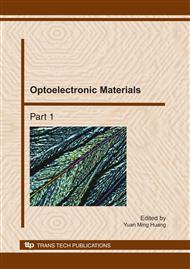[1]
A. Aviram and M.A. Ratner: Chem. Phys. Lett. Vol. 29 (1974), p.277.
Google Scholar
[2]
K. Moth-Poulsen1 and T. Bjørnholm: Nature Nanotech. Vol. 4 (2009), p.551.
Google Scholar
[3]
A. Błaszczyk, M. Chadim, C. von Hänisch and M. Mayor: Eur. J. Org. Chem. Vol. 2006 (2006), p.3809.
DOI: 10.1002/ejoc.200600336
Google Scholar
[4]
J. Otsuki, T. Akasaka and K. Araki: Coordin. Chem. Rev. Vol. 252 (2008), p.32.
Google Scholar
[5]
Y.W. Li, J.W. Zhao, X. Yin and G.P. Yin: ChemPhysChem Vol. 7 (2006), p.2593.
Google Scholar
[6]
H. Nakanishi, K. Miyamoto, M.Y. David, E.S. Dy, R. Tanaka and H. Kasai: J. Phys.: Condens. Matter Vol. 19 (2007), p.365234.
DOI: 10.1088/0953-8984/19/36/365234
Google Scholar
[7]
Y.W. Li, J.H. Yao, C.J. Liu, J.W. Yang and C.L. Yang: Phys. Lett. A. Vol. 373 (2009), p.3974.
Google Scholar
[8]
S.U. Lee, R.V. Belosludov, H. Mizuseki and Y. Kawazoe: Small Vol. 4 (2008), p.962.
Google Scholar
[9]
Gaussian 09, Revision A. 02, Gaussian, Inc., Wallingford CT, (2009).
Google Scholar
[10]
Y.W. Li, J.W. Zhao, X. Yin, H.M. Liu and G.P. Yin: Phys. Chem. Chem. Phys. Vol. 9 (2007), p.1186.
Google Scholar
[11]
J.C. Cuevas, J. Heurich, F. Pauly, W. Wenzel and G. Schon: Nanotechnology Vol. 14 (2003), p. R29.
Google Scholar
[12]
S. Sen and S. Chakrabarti: J. Phys. Chem. C. Vol. 112 (2008), p.15537.
Google Scholar
[13]
J. Taylor, H. Guo and J. Wang: Phys. Rev. B Vol. 63 (2001), p.245407.
Google Scholar
[14]
K. Stokbro, J. Taylor and M. Brandbyge: J. Am. Chem. Soc. Vol. 125 (2003), p.3674.
Google Scholar
[15]
A. Salomon, D. Cahen, S. Lindsay, J. Tomfohr, V.B. Engelkes and C.D. Frisbie: Adv. Mater. Vol. 15 (2003), p.1.
DOI: 10.1002/adma.200306091
Google Scholar
[16]
Y.W. Li, J.W. Zhao, X. Yin and G.P. Yin: J. Phys. Chem. A Vol. 110 (2006), p.11130.
Google Scholar
[17]
G. Sedghi, K. Sawada, L.J. Esdaile, M. Hoffmann, H.L. Anderson, D. Bethell, W. Haiss, S.J. Higgins and R.J. Nichols: J. Am. Chem. Soc. Vol. 130 (2008), p.8582.
DOI: 10.1021/ja802281c
Google Scholar
[18]
H. Meier: Angew. Chem. Int. Ed. Vol. 48 (2009), p.3911.
Google Scholar


